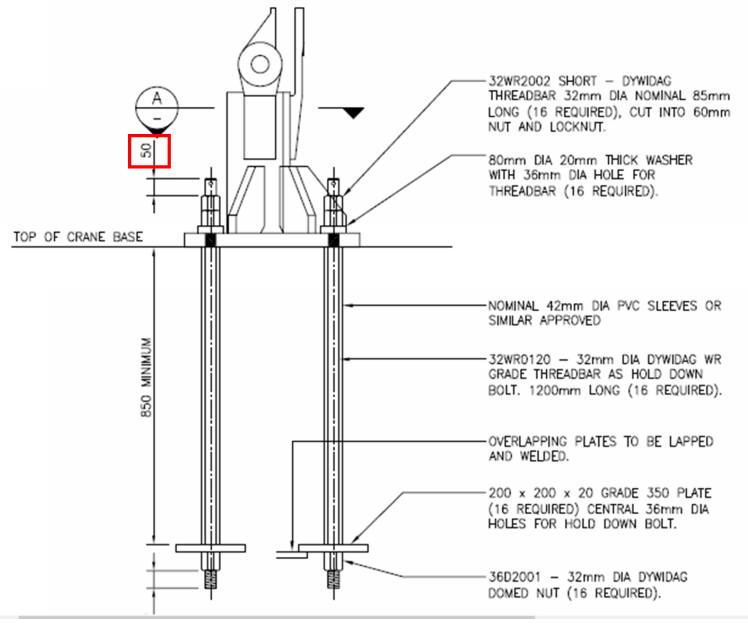Temporaryworks
Structural
Hi,
I have a query regarding pre-load applied to tower crane anchors. I am a Temporary Works Designer and have experience with designing tower cranes with sacrificial cast in bottom tower sections but not traditional holding down bolts. I have produced a preliminary anchor bolt design including specifying pre-load to apply to the crane and also have requested confirmation of pre-load bolt testing to be supplied to me. I am not entirely 100% confident that my specified pre-load is correct and I am also not 100% sure what I want to see in the test results when they come through.
Some background to the question is bulleted below and shown in attachment which you will need to read at the same time to get a feel for this:
- Tower crane is anchored in to a deep reinforcement concrete base which is piled.
-To give you an idea of the tower crane: It is a Potain MC85B and is 36.1m height under hook (approx 45m from top to bottom for those not in the know) and has a jib length of 45m.
- Unfactored tensile load in crane foot = -716.13kN. 4no anchors per foot therefore -179.03kN tension per anchor.
- Yield load of 32mm anchor = 764kN SWL of anchor = 1/3 of yield = 229.2kN.
-Pre load = 50% of elastic limit of anchor road = 382kN as per manufacturer's recommendations which are shown attached.
- Difference between specified pre-load and working load = 203kN or +122% of working load
I have been reading eng-tips threads on pre-load, boltscience.com and John H.Bickford's book and have come to the conclusion that bolt pre-load determination can be very complicated! I think that my pre-load is more than enough to make up for elastic losses etc + accuracy of pre-load application etc etc and still have a decent margin of safety.
My first Qn is - is my calculation of the pre-load, as per manufacturer's instructions, sufficient/detailed enough given the risk and high forces involved in a tower crane anchor design? I am fairly sure that most TW designers do not use anchor design methods beyond what I have described here but I wonder if we should be doing this?
My section Qn is - what preparation do I need to do in readiness for the test results from the bolt pre-load contractors or do I need to give them more specific instructions regarding the sort of test that I want?
NOTE: CAST IN ANCHOR PLATE HAS NOT BEEN FINALISED AND WILL LIKELY INCREASE TO 40mm ONCE UNDERTAKEN.
Thanks in advance.
I have a query regarding pre-load applied to tower crane anchors. I am a Temporary Works Designer and have experience with designing tower cranes with sacrificial cast in bottom tower sections but not traditional holding down bolts. I have produced a preliminary anchor bolt design including specifying pre-load to apply to the crane and also have requested confirmation of pre-load bolt testing to be supplied to me. I am not entirely 100% confident that my specified pre-load is correct and I am also not 100% sure what I want to see in the test results when they come through.
Some background to the question is bulleted below and shown in attachment which you will need to read at the same time to get a feel for this:
- Tower crane is anchored in to a deep reinforcement concrete base which is piled.
-To give you an idea of the tower crane: It is a Potain MC85B and is 36.1m height under hook (approx 45m from top to bottom for those not in the know) and has a jib length of 45m.
- Unfactored tensile load in crane foot = -716.13kN. 4no anchors per foot therefore -179.03kN tension per anchor.
- Yield load of 32mm anchor = 764kN SWL of anchor = 1/3 of yield = 229.2kN.
-Pre load = 50% of elastic limit of anchor road = 382kN as per manufacturer's recommendations which are shown attached.
- Difference between specified pre-load and working load = 203kN or +122% of working load
I have been reading eng-tips threads on pre-load, boltscience.com and John H.Bickford's book and have come to the conclusion that bolt pre-load determination can be very complicated! I think that my pre-load is more than enough to make up for elastic losses etc + accuracy of pre-load application etc etc and still have a decent margin of safety.
My first Qn is - is my calculation of the pre-load, as per manufacturer's instructions, sufficient/detailed enough given the risk and high forces involved in a tower crane anchor design? I am fairly sure that most TW designers do not use anchor design methods beyond what I have described here but I wonder if we should be doing this?
My section Qn is - what preparation do I need to do in readiness for the test results from the bolt pre-load contractors or do I need to give them more specific instructions regarding the sort of test that I want?
NOTE: CAST IN ANCHOR PLATE HAS NOT BEEN FINALISED AND WILL LIKELY INCREASE TO 40mm ONCE UNDERTAKEN.
Thanks in advance.


